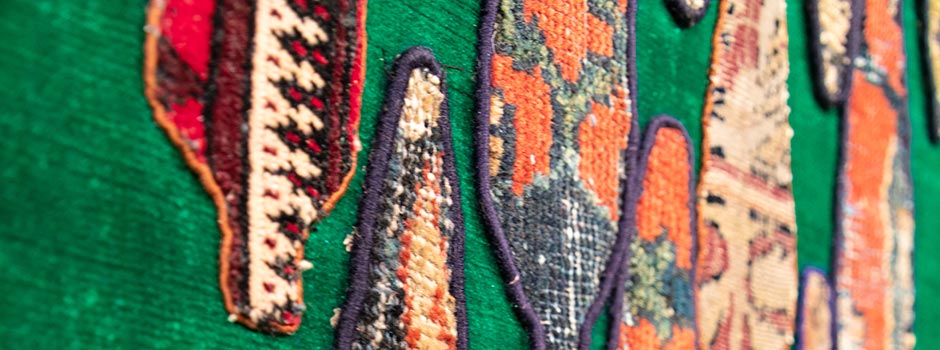
Exhibition at the Aga Khan Centre Gallery (27 Feb – 3 May 2020) Rethreading and Retracing: Textiles & Techniques by Bita Ghezelayagh
Mar 20, 2020 INSPO, Exhibition

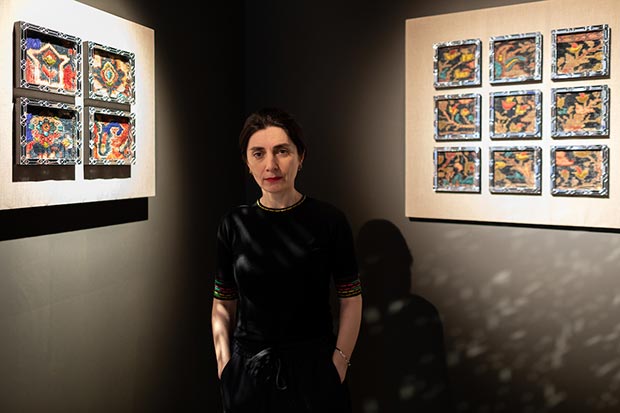 Iranian textile artist Bita Ghezelayagh / Courtesy of Aga Khan Centre Gallery
Iranian textile artist Bita Ghezelayagh / Courtesy of Aga Khan Centre Gallery
Somewhere between an artisan and a conceptual artist, Ghezelayagh uses her style to add a distinctively modern character to textiles of the past. Her work evokes grand themes of courtship, kingship, communication, and glories of war while simultaneously celebrating the humblest units of artistic creation: the stitch, knot, and rivet.
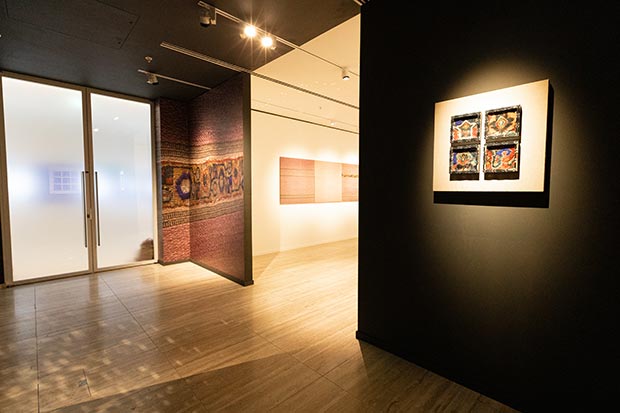 Bita Ghezelayagh, installation view from the exhibition / Courtesy of Aga Khan Centre Gallery
Bita Ghezelayagh, installation view from the exhibition / Courtesy of Aga Khan Centre Gallery
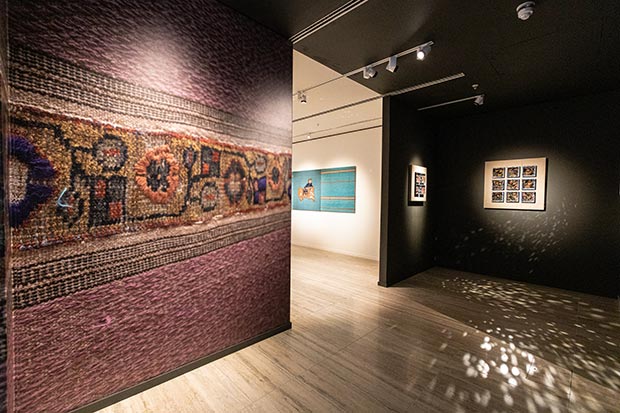 Bita Ghezelayagh, installation view from the exhibition / Courtesy of Aga Khan Centre Gallery
Bita Ghezelayagh, installation view from the exhibition / Courtesy of Aga Khan Centre Gallery
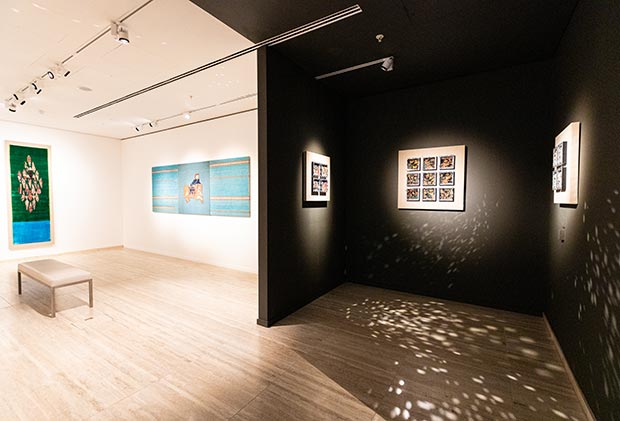 Bita Ghezelayagh, installation view from the exhibition / Courtesy of Aga Khan Centre Gallery
Bita Ghezelayagh, installation view from the exhibition / Courtesy of Aga Khan Centre Gallery
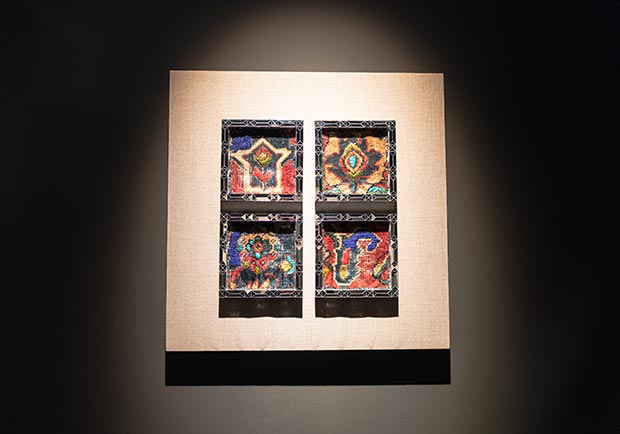 Bita Ghezelayagh, installation view from the exhibition / Courtesy of Aga Khan Centre Gallery
Bita Ghezelayagh, installation view from the exhibition / Courtesy of Aga Khan Centre Gallery
The exhibition begins with an invitation into a darkened space that shimmers in the far corner, attracting the viewer to take a closer look. Tile-sized mirror works echo the elaborate muqarnas of Islamic architecture. These are placed in a more intimate space while her other works, bathed in light, catch the viewer’s eye with flashes of bright velvety colours and an array of textures and tones. The exhibition reveals the artist’s masterful and inventive use of her trademark materials: velvet, silk, felt, and carpet fragments. Each piece is a showcase for her probing creativity and the skill of the original masters who created the old textile pieces she uses.
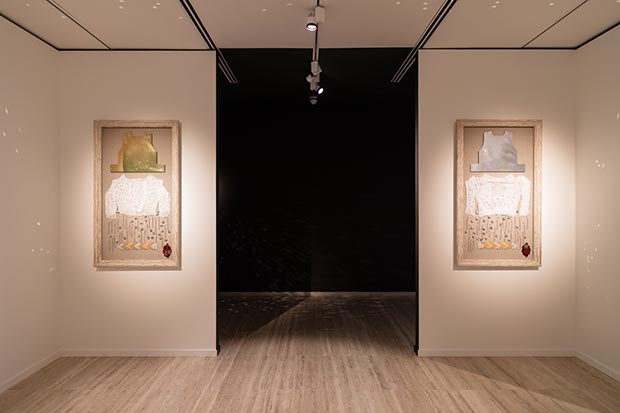 Bita Ghezelayagh, installation view from the exhibition / Courtesy of Aga Khan Centre Gallery
Bita Ghezelayagh, installation view from the exhibition / Courtesy of Aga Khan Centre Gallery
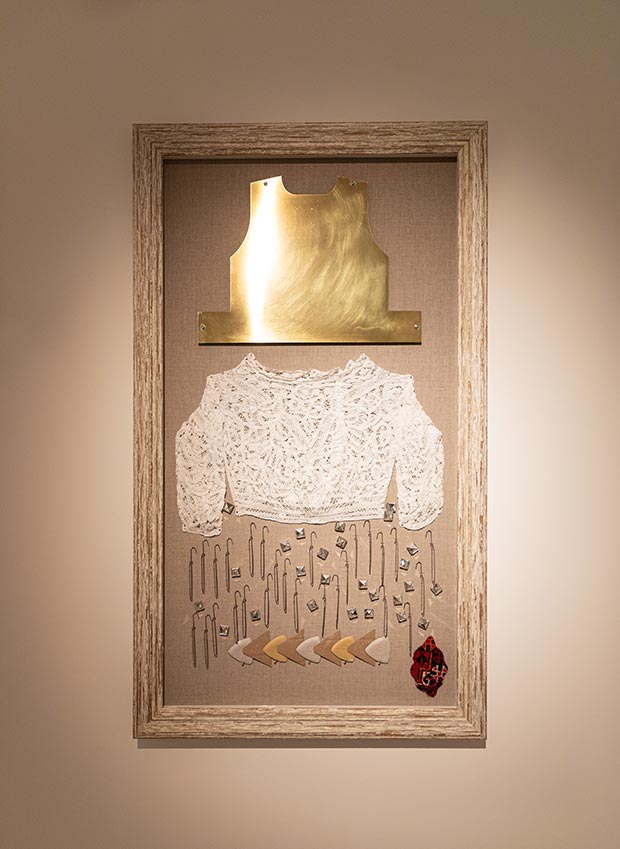 Bita Ghezelayagh, installation view from the exhibition / Courtesy of Aga Khan Centre Gallery
Bita Ghezelayagh, installation view from the exhibition / Courtesy of Aga Khan Centre Gallery
 Bita Ghezelayagh, detail / Courtesy of Aga Khan Centre Gallery
Bita Ghezelayagh, detail / Courtesy of Aga Khan Centre Gallery
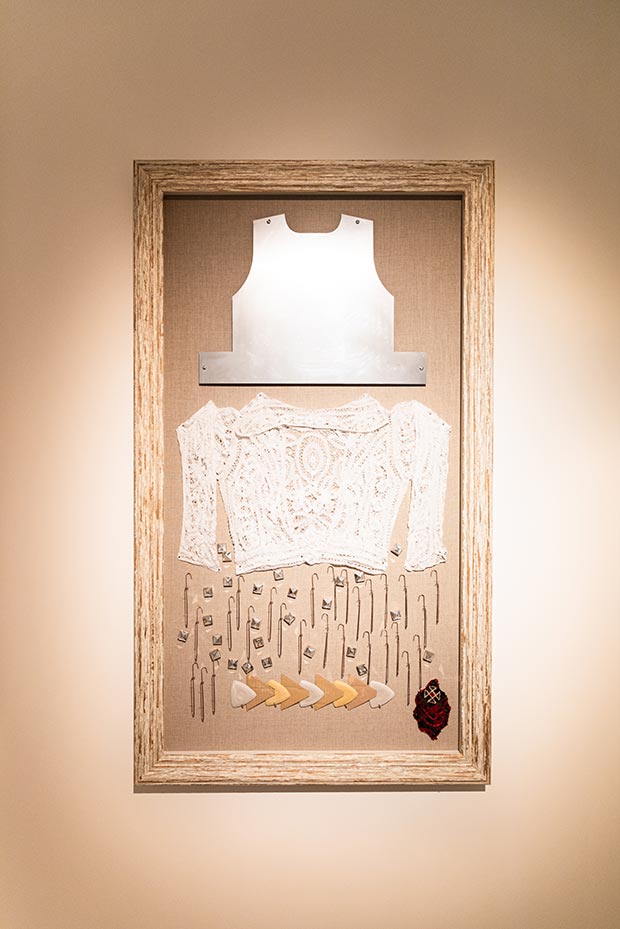 Bita Ghezelayagh, installation view from the exhibition / Courtesy of Aga Khan Centre Gallery
Bita Ghezelayagh, installation view from the exhibition / Courtesy of Aga Khan Centre Gallery
Ghezelayagh’s works are the story of cutters, weavers, embroiderers, and printers. Using their artefacts, the artist elevates items such as threadbare rugs to make a statement about our age of casual disposal. Her triptychs make use of discarded materials such as traditional scrubbing gloves, while her diptych, with its velvet woven over several months on a traditional loom, is decorated with the shapes of Cypress Trees. These are fashioned from scraps of carpets from the four corners of Iran, each one representative of a different artistic tradition, but meeting here as an expression of a bigger cultural whole.
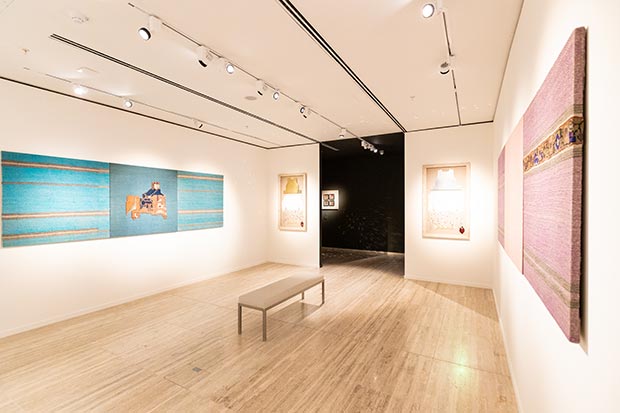 Bita Ghezelayagh, installation view from the exhibition / Courtesy of Aga Khan Centre Gallery
Bita Ghezelayagh, installation view from the exhibition / Courtesy of Aga Khan Centre Gallery
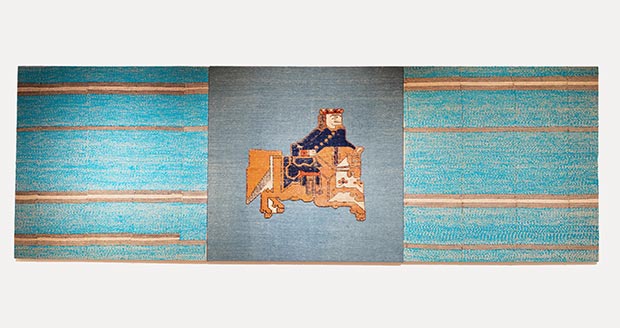 Bita Ghezelayagh, installation view from the exhibition / Courtesy of Aga Khan Centre Gallery
Bita Ghezelayagh, installation view from the exhibition / Courtesy of Aga Khan Centre Gallery
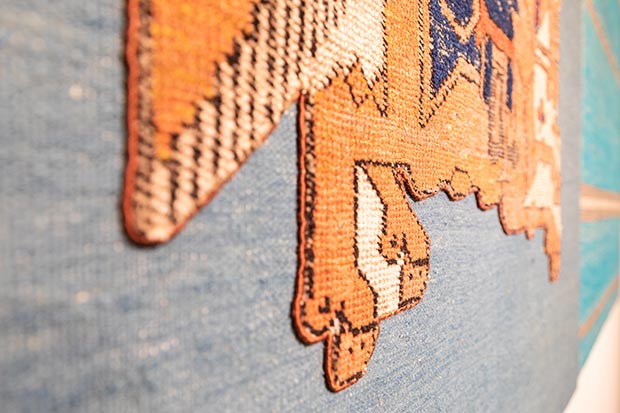 Bita Ghezelayagh, detail / Courtesy of Aga Khan Centre Gallery
Bita Ghezelayagh, detail / Courtesy of Aga Khan Centre Gallery
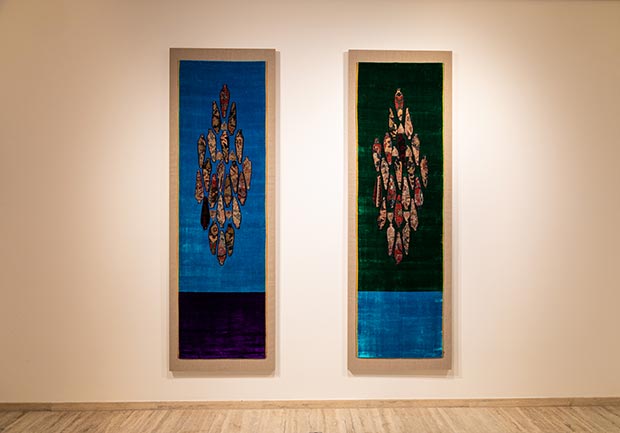 Bita Ghezelayagh, installation view from the exhibition / Courtesy of Aga Khan Centre Gallery
Bita Ghezelayagh, installation view from the exhibition / Courtesy of Aga Khan Centre Gallery
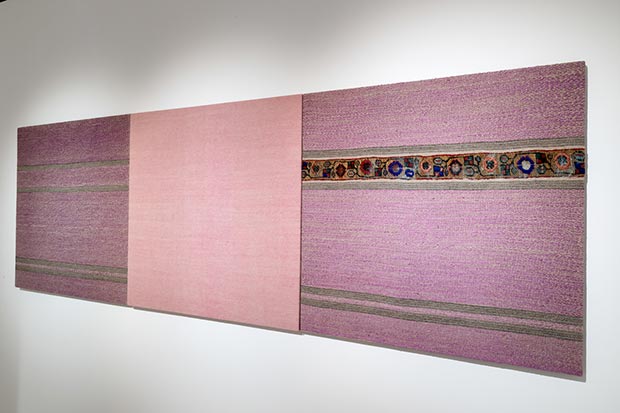 Bita Ghezelayagh, installation view from the exhibition / Courtesy of Aga Khan Centre Gallery
Bita Ghezelayagh, installation view from the exhibition / Courtesy of Aga Khan Centre Gallery
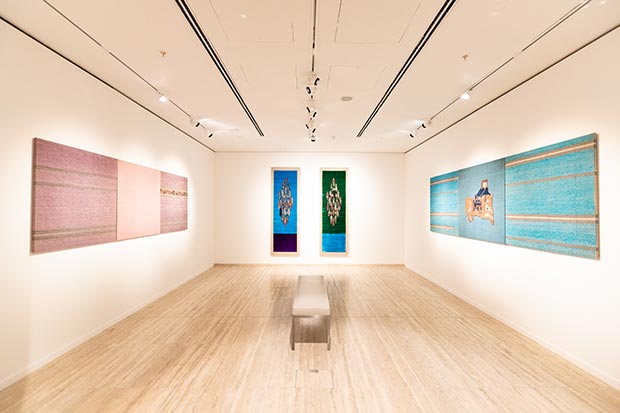 Bita Ghezelayagh, installation view from the exhibition / Courtesy of Aga Khan Centre Gallery
Bita Ghezelayagh, installation view from the exhibition / Courtesy of Aga Khan Centre Gallery
The human body has been a point of departure for Ghezelayagh for much of her artistic life. Her work includes shepherds’ cloaks, carpet tunics, and metal breastplates. The conundrum of human communication, represented by pen nib motifs, is also a preoccupation. She also uses mirror shapes to form compositions reminiscent of Islamic geometric patterns found throughout Iran that allude to her cultural heritage.
Ghezelayagh is an artist whose fascination with historical textile materials and contemporary objects inspires the need to rethread, retrace, renew, and reinvent her collection of archival materials she has collected for most of her life. Her practice transforms the ordinary into the extraordinary, giving a new sense of purpose by shifting a material’s identity.
 Bita Ghezelayagh, installation view from the exhibition / Courtesy of Aga Khan Centre Gallery
Bita Ghezelayagh, installation view from the exhibition / Courtesy of Aga Khan Centre Gallery
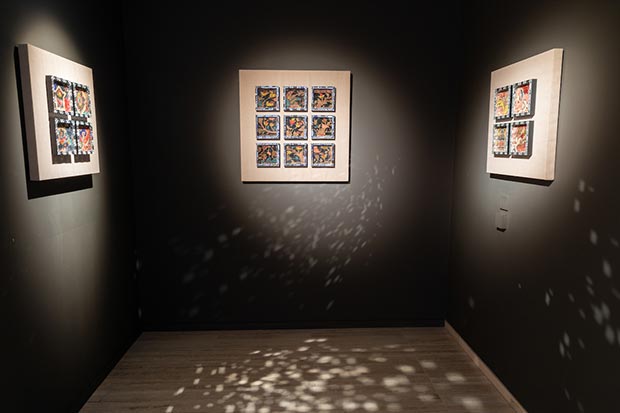 Bita Ghezelayagh, installation view from the exhibition / Courtesy of Aga Khan Centre Gallery
Bita Ghezelayagh, installation view from the exhibition / Courtesy of Aga Khan Centre Gallery
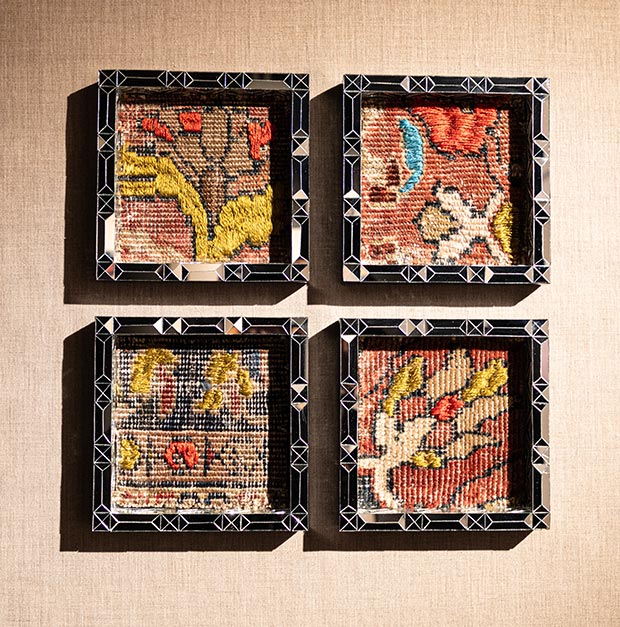 Bita Ghezelayagh, installation view from the exhibition / Courtesy of Aga Khan Centre Gallery
Bita Ghezelayagh, installation view from the exhibition / Courtesy of Aga Khan Centre Gallery
 Bita Ghezelayagh, installation view from the exhibition / Courtesy of Aga Khan Centre Gallery
Bita Ghezelayagh, installation view from the exhibition / Courtesy of Aga Khan Centre Gallery
Bita Ghezelayagh was born in Florence, Italy, and lives in London. She has an MA in Architecture from the Ecole Nationale Supérieure d’Architecture de Paris La Villette. She worked for the Associ¬ation of Iranian Calligraphers in Tehran and was art director of three notable Iranian films, including The Pear Tree by Dariush Mehrjui.
In 2003, she studied felt-making in Iran and had her first solo exhibition at the House of Artists Khane Honarmandan in Tehran, 2008. She has had numerous solo exhibitions, both in the UK and internationally, including Rose Issa Projects: The Letter that never arrived and Felt Memories. Her touring exhibition Nomad: A Persian Journey in Felt at The Collins Gallery (University of Strathclyde) also travelled to the Quilt Museum and Hawick Museum. She has had solo exhibitions also at Albahreh Gallery, and Golestan Gallery, Tehran.
Ghezelayagh's work has been exhibited in group exhibitions across the world, including Lajevardi Foundation, Shirin Gallery, Aaran Projects Gallery in Tehran. She has taken part in major art festivals and exhibitions at Sharjah Museum of Contemporary Art, Herbert Art Gallery and Museum, the Jameel Prize at Victoria & Albert Museum, Institute du Monde Arab, Casa Arabe, Cantor Arts Centre, San Antonio Museum of Art, Centro Cultural Banco do Brazil, Beirut Exhibition Centre, and Art Dubai. Her work is in public and private collections, including the British Museum, the Farjam Foundation, Devi Art Foundation, Jameel Foundation, and most recently, within the Islamic Middle East Collection, at the Victoria & Albert Museum.
The exhibition Rethreading and Retracing: Textiles & Techniques is supported by the Aga Khan Foundation (UK).
Comments
Add a comment